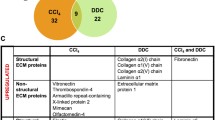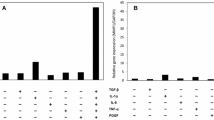Abstract.
Matrix metalloproteinases (MMPs) and their specific inhibitors (TIMPs) are thought to play an essential role in liver injury associated with tissue remodeling. However, their distinct expression profile in different liver repair models still remains to be established. Hepatic expression of collagenase (MMP-13), gelatinases A and B (MMP-2, -9), stromelysin-1 and -2 (MMP-3, -10), membrane-type MMP-1 (MMP-14), and TIMP-1 and -2 was studied following single and repeated CCl4-mediated injury and after partial hepatectomy. Expression was analyzed by reverse transcription-PCR (RT-PCR), northern blot analysis, zymography, and immunohistochemistry. Following a single toxic liver injury, MMPs and TIMPs were induced in a distinct time frame in that expression of most MMPs was induced during the early phase of liver injury, was maximal during the inflammatory reaction, and was diminished in the recovery phase. In contrast, TIMP and MMP-2 steady state mRNA levels remained constant in the early phase, were strongly induced during tissue inflammation, and remained increased until the recovery phase. Interestingly, hepatic TNF-α expression paralleled the MMP induction profile, while the increase of TGF-β1 expression mapped to the increase of TIMPs. Chronic liver injury was accompanied by an increase in the steady state mRNA levels of MMP-2 and TIMPs, while other MMPs remained more or less unchanged or were diminished. Partial hepatectomy was followed by a dramatic increase of MMP-14 and to a lesser extent also of TIMP-1 expression; other MMPs and TIMPs were not significantly induced. Liver injury is accompanied by profound changes in hepatic MMP/TIMP expression, the latter being critically dependent on the type of injury. Single toxic injury resulting in complete restoration was characterized by a sequential induction of MMPs and TIMPs suggesting initial matrix breakdown and matrix restoration thereafter. Chronic liver injury leading to fibrosis displays overall diminished matrix degradation mainly through TIMP induction, while liver regeneration induced by partial hepatectomy caused an induction of MMP-14 and TIMP-1 only, which might be unrelated to matrix turnover but connected to pericellular fibrinolysis or fibrolysis required for hepatocellular replication.
Similar content being viewed by others
Author information
Authors and Affiliations
Additional information
Electronic Publication
Rights and permissions
About this article
Cite this article
Knittel, T., Mehde, M., Grundmann, A. et al. Expression of matrix metalloproteinases and their inhibitors during hepatic tissue repair in the rat. Histochem Cell Biol 113, 443–453 (2000). https://doi.org/10.1007/s004180000150
Accepted:
Issue Date:
DOI: https://doi.org/10.1007/s004180000150




